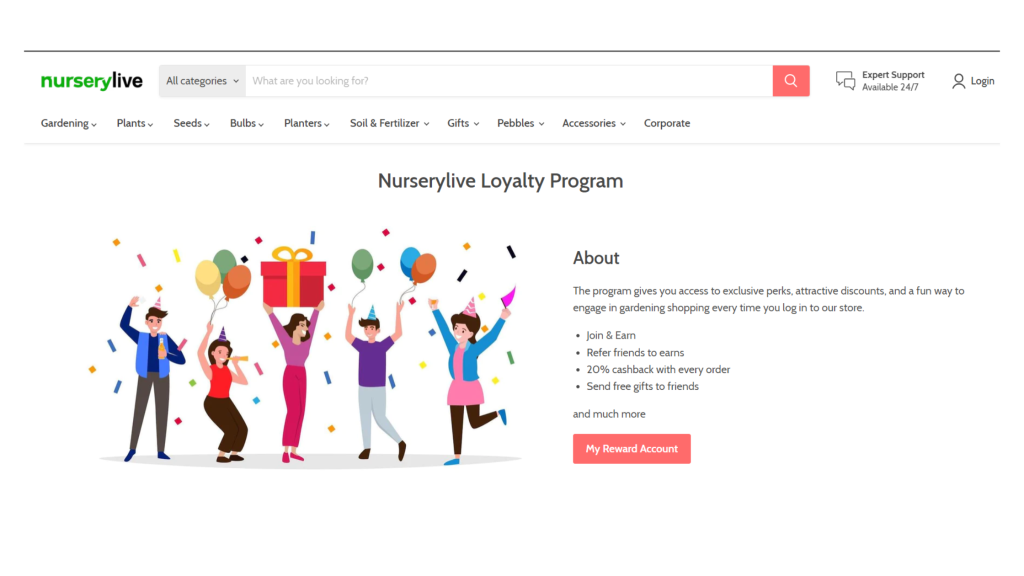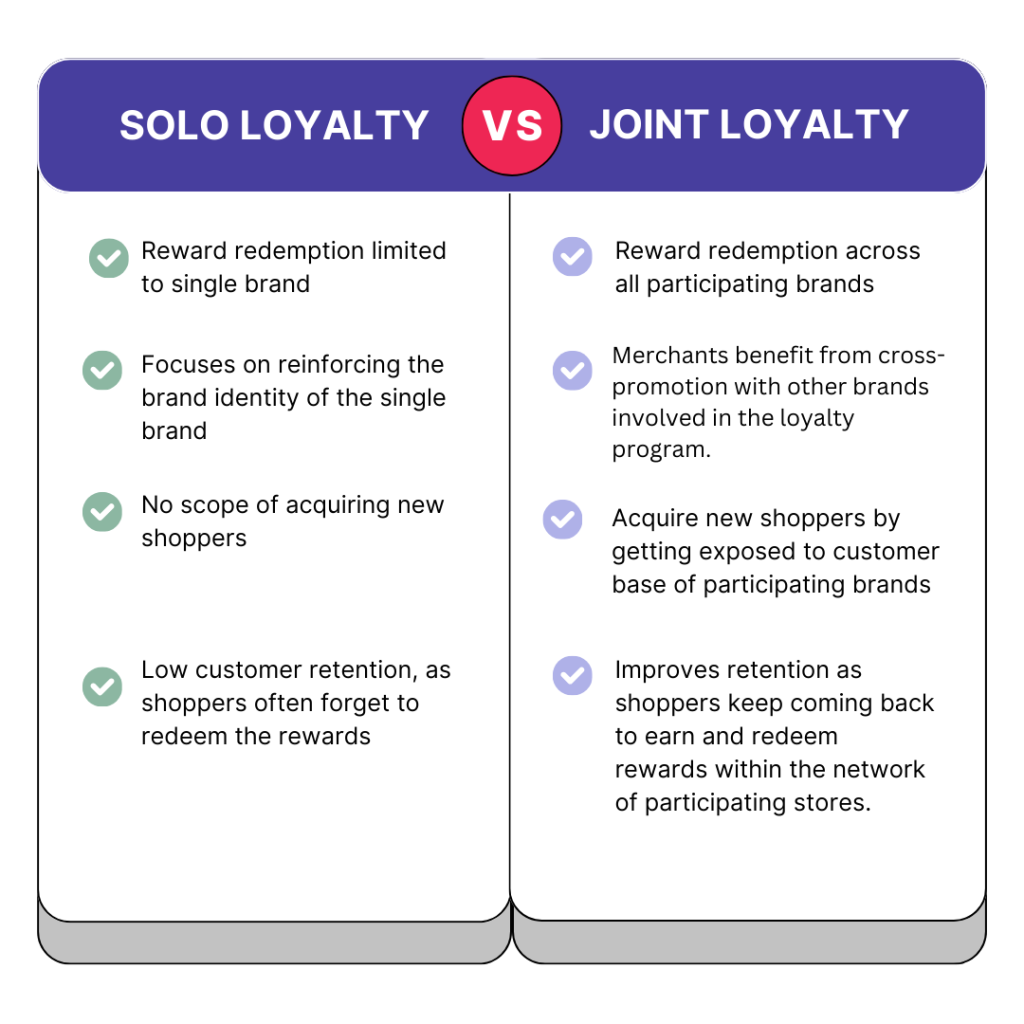Sometimes you need to incentivize customers to keep coming back to your store. Brands often offer special discounts and other exciting deals to repeat buyers to foster loyalty. This is what is called a loyalty program.
If executed properly, loyalty programs can help your customers feel valuable. According to a recent survey, businesses with well-implemented loyalty programs witness a 20% increase in customer retention on average.
In this article, we will talk about the differences between two prominent types of loyalty programs: solo loyalty and joint loyalty. While solo loyalty has been predominant in the eCommerce industry for a long time, joint loyalty is going to reign in 2024 and going forward.
In simple words, solo loyalty programs are individual brand-centric, focusing on rewarding shoppers for their individual purchases. On the other hand, joint loyalty programs involve collaborations between multiple brands to create a unified loyalty experience for shoppers.
What is Solo Loyalty Program?
Solo Loyalty is a type of loyalty where individual shoppers are rewarded based on their personal purchasing behavior. In this model, brands offer rewards and incentives to cater specifically to the preferences and habits of each shopper. Features may include personalized discounts, exclusive offers, and points accumulation systems.


Types of Solo Loyalty Programs:
- Points-Based Systems: Shoppers earn points for each purchase, which can be redeemed for future discounts or free products.
- Tiered Loyalty Programs: Offering escalating benefits as shoppers move through different loyalty tiers based on their cumulative spending.
- Paid loyalty programs: Paid loyalty, or fee-based loyalty programs, give customers immediate and ongoing benefits for a participation fee. These fees can be recurring or one-time.
Know more about these loyalty programs here.
Why do solo loyalty programs often fail?
The amount of unclaimed loyalty points has been estimated to be as high as $100 billion. This clearly shows solo loyalty programs don’t always work the way they are supposed to.
Solo loyalty often fails because shoppers either forget to redeem their rewards or the rewards aren’t exciting enough. Also, shoppers some times may not feel emotionally connected to your brand especially when the focus of the loyalty program is only on discounts. This reduces the effectiveness of the loyalty program.
And that’s why Joint Loyalty programs are on the rise.
What is joint loyalty program?
Joint Loyalty Programs in eCommerce involve collaborative efforts between multiple brands to create a unified loyalty experience for customers. In these programs, shoppers can earn and redeem rewards across a network of participating stores. The characteristics include shared rewards, cross-promotions, and a seamless customer experience across different participating brands.
For example, if you shop from Shopper’s Stop, you can use the loyalty card of Shopper’s across its participating brands such as Home Stop, French Connection, U R You and more.
In India, PAYBACK was launched in 2010 and is today one of India’s largest Multi-Brand loyalty programs with over 100 million members, and more than a hundred partner brands, such as Big Bazaar, Hindustan Petroleum (HPCL), ICICI Bank, etc.
Marketplace giants like Amazon, Flipkart, and Myntra have won over lakhs of devoted followers. They have aced the game of joint loyalty!
Joint Loyalty Programs in eCommerce involve collaborative efforts between multiple brands to create a unified loyalty experience for customers. In these programs, shoppers can earn and redeem rewards across a network of participating stores. The characteristics include shared rewards, cross-promotions, and a seamless customer experience across different participating brands.
For example, if you shop from Shopper’s Stop, you can use the loyalty card of Shopper’s across its participating brands such as Home Stop, French Connection, U R You and more.
In India, PAYBACK was launched in 2010 and is today one of India’s largest Multi-Brand loyalty programs with over 100 million members, and more than a hundred partner brands, such as Big Bazaar, Hindustan Petroleum (HPCL), ICICI Bank, etc.
Marketplace giants like Amazon, Flipkart, and Myntra have won over lakhs of devoted followers. They have aced the game of joint loyalty!
Picture this: Meet Nisha, our smart online shopper. She recently snagged a fabulous dress from brand X on Amazon and effortlessly found the perfect pair of shoes from brand Y to complete her ensemble. What’s truly delightful isn’t just the convenience of one-stop shopping but the trust Nisha places in Amazon itself. Even though she’s never ventured into these brands’ individual online stores, she’s developed a deep trust in Amazon that keeps her coming back.
Joint loyalty programs function similarly. Shoppers can accumulate and redeem rewards from multiple brands within the program, fostering loyalty to the entire ecosystem.
Benefits of Joint Loyalty Programs for Merchants:
- Wider Customer Base: Joint loyalty programs involve multiple brands. This exposed eCommerce sellers to a broader audience, attracting more customers that they never had before.
- Increased Retention: The collaborative approach of a joint loyalty program leads to higher customer retention rates as customers have more opportunities to earn and redeem rewards within the network of participating stores.
- Cross Promotion: The exposure to different shoppers increases brand visibility, driving traffic and potential sales for your store.
What experts say:
Joint loyalty programs for E-commerce businesses offer several advantages over solo loyalty programs. First, they enable businesses to pool resources and customer bases, expanding the program's reach and impact. Second, a joint loyalty program can provide a more diverse range of rewards and incentives, catering to a broader audience and increasing the overall attractiveness of the program. These benefits make joint loyalty programs a strategic and mutually beneficial approach for E-commerce businesses.
Kartik Ahuja, CEO, Growth Scribe Tweet
I've worked with a lot of E-commerce businesses, and I've found that the biggest benefit of a joint loyalty program is that it helps your customers feel more like they're part of a community. If you offer a 10% discount to all customers who sign up for your loyalty program, it's pretty easy for your customers to forget about that discount after they join. Plus, it's usually only good for one year—and then what? Do you convince them again to sign up next year? With joint loyalty, you can offer an ongoing discount to all customers who sign up with your partner program. That way, your customers aren't only getting a discount on their first purchase—they're getting a discount on every purchase they make with you or your partner company. Joint loyalty tend to be easier on the wallet than solo ones. You don't have to spend time developing and maintaining your loyalty program; instead, you can just focus on building relationships with other companies in your industry who already have one and see if there's room for collaboration.
Luka Blaževac, CEO, Incendio Wands Tweet
Benefits of Joint Loyalty Programs for Shoppers:
- More Redemption Options: Shoppers can redeem rewards at various participating brands, providing a broader range of choices.
- Enhanced Value: Joint loyalty programs often offer more substantial rewards and exclusive perks due to the collective contributions of participating brands.
- Integrated Experience: Seamless and interconnected loyalty experiences across different businesses, making it convenient for consumers to engage with the program.
Research shows, 75% of customers participating in joint loyalty programs express higher satisfaction compared to traditional solo loyalty initiatives. Accenture report shows 63% of customers are more likely to become part of a joint loyalty as compared to a solo loyalty
Solo Loyalty Vs Joint Loyalty


Enhance Customer Retention with WyseMe
Retaining a customers costs a brand 5X lesser than acquiring a new customer.
Improve your customer retention with WyseMe, an AI-driven joint loyalty and rewards platform built to revolutionize customer acquisition and retention for brands, all at an affordable cost.
WyseMe’s advanced AI engine evaluates shoppers across participating stores, rewarding them with Wyse points after each purchase. These points can be redeemed for gift cards from any of the participating brands, enhancing the overall shopping experience.
Know more about WyseMe’s joint loyalty here.



